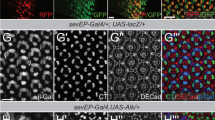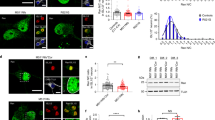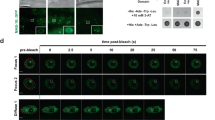Abstract
Human and mouse Abelson interacting proteins (Abi) are SH3-domain containing proteins that bind to the proline-rich motifs of the Abelson protein tyrosine kinase. We report a new member of this gene family, a Drosophila Abi (dAbi) that is a substrate for Abl kinase and that co-immunoprecipitates with Abl if the Abi SH3 domain is intact. We have identified a new function for both dAbi and human Abi-2 (hAbi-2). Both proteins activate the kinase activity of Abl as assayed by phosphorylation of the Drosophila Enabled (Ena) protein. Removal of the dAbi SH3 domain eliminates dAbi's activation of Abl kinase activity. dAbi is an unstable protein in cells and is present at low steady state levels but its protein level is increased coincident with phosphorylation by Abl kinase. Expression of the antisense strand of dAbi reduces dAbi protein levels and abolishes activation of Abl kinase activity. Modulation of Abi protein levels may be an important mechanism for regulating the level of Abl kinase activity in the cell.
This is a preview of subscription content, access via your institution
Access options
Subscribe to this journal
Receive 50 print issues and online access
$259.00 per year
only $5.18 per issue
Buy this article
- Purchase on Springer Link
- Instant access to full article PDF
Prices may be subject to local taxes which are calculated during checkout







Similar content being viewed by others
References
Barila D and Superti-Furga G. . 1998 Nature Genetics 18: 280–282.
Baskaran R, Chiang GC and Wang JY. . 1996 Mol. Cell Biol. 16: 3361–3369.
Biesova Z, Piccoli C and Wong WT. . 1997 Oncogene 14: 233–241.
Dai Z and Pendergast AM. . 1995 Genes Dev. 9: 2569–2582.
Diehl JA, Zindy F and Sherr CJ. . 1997 Genes Dev. 11: 957–972.
Feller SM, Ren R, Hanafusa H and Baltimore D. . 1994 Trends Biochem. Sci. 19: 453–458.
Fernandes RS, Gorman AM, McGahon A, Lawlor M, McCann S and Cotter TG. . 1996 Leukemia 10 (Suppl 2): 517–521.
Franz WM, Berger P and Wang JYJ. . 1989 EMBO J. 8: 137–147.
Gertler FB, Comer AR, Juang J-L, Ahern SM, Clark MJ, Liebl EC and Hoffmann FM. . 1995 Genes Dev. 9: 521–533.
Gertler FB, Hill KK, Clark MJ and Hoffmann FM. . 1993 Genes Dev. 7: 441–453.
Goff SP, Gilboa E, Witte ON and Baltimore D. . 1980 Cell 22: 777–785.
Goga A, McLaughlin J, Pendergast AM, Parmar K, Muller A, Rosenberg N and Witte ON. . 1993 Mol. Cell Biol. 13: 4967–4975.
Henkemeyer M, West SR, Gertler FB and Hoffmann FM. . 1990 Cell 63: 949–960.
Hoffmann FM. . 1991 Trends Genetics 7: 351–355.
Jackson P and Baltimore D. . 1989 EMBO J. 8: 449–456.
Lavin MF, Watters D and Song Q. . 1996 Experientia 52: 979–994.
Levine AJ, Perry ME, Chang A, Silver A, Dittmer D, Wu M and Welsh D. . 1994 Br. J. Cancer 69: 409–416.
Luscher B and Eisenman RN. . 1988 Mol. Cell. Biol. 8: 2504–2512.
Mayer BJ and Baltimore D. . 1994 Mol. Cell. Biol. 14: 2883–2894.
Musti AM, Treier M and Bohmann D. . 1997 Science 275: 400–402.
Pendergast AM, Muller AJ, Havlik MH, Clark R, McCormick F and Witte ON. . 1991 Proc. Natl. Acad. Sci. USA 88: 5927–5931.
Perry ME and Levine AJ. . 1993 Curr. Opin. Genet. Dev. 3: 50–54.
Reddy BA, Kloc M and Etkin LD. . 1992 Mech. Develop. 39: 143–150.
Rogers S, Wells R and Rechsteiner M. . (1986). Amino acid sequences common to rapidly degraded proteins: the PEST hypothesis Science 234: 364–368.
Rosenberg N and Witte ON. . 1988 Adv. Virus Res. 35: 39–81.
Shah GN, Li J, Schneiderjohn P and Mooradian AD. . 1997 Biochem J. 327: 617–623.
Shi Y, Kimona A and Goff SP. . 1995 Genes Dev. 9: 2583–2597.
Wang B, Mysliwiec T, Krainc D, Jensen RA, Sonoda G, Testa JR, Golemis EA and Kruh GD. . 1996 Oncogene 12: 1921–1929.
Wang JYJ. . 1993 Curr. Opin. Genet. Dev. 3: 35–43.
Willems AR, Lanker S, Patton EE, Craig KL, Nasopn TF, Mathias N, Kobayashi R, Wittenberg C and Tyers M. . 1996 Cell 86: 453–463.
Yuan Z, Huang Y, Ishiko T, Kharbanda S, Weichselbaum R and Kufe D. . 1997 Proc. Natl. Acad. Sci. USA 94: 1437–1440.
Ziemnicka-Kotula D, Xu J, Gu H, Potempska A, Kim KS, Jenkins EC, Trenkner E and Kotula L. . 1998 J. Biol. Chem. 273: 13681–13692.
Acknowledgements
We would like to thank Drs AM Pendergast, GD Kruh, and FJ Fogerty for providing reagents and helpful discussions, Dr SP Goff for reagents, Drs HJ Kung, AR Comer and SM Ahern-Djamali for helpful discussions. This work was supported by NIH grant #CA49582 to FM Hoffmann and by Cancer Core Grant #07175.
Author information
Authors and Affiliations
Rights and permissions
About this article
Cite this article
Juang, JL., Hoffmann, F. Drosophila Abelson interacting protein (dAbi) is a positive regulator of Abelson tyrosine kinase activity. Oncogene 18, 5138–5147 (1999). https://doi.org/10.1038/sj.onc.1202911
Received:
Revised:
Accepted:
Published:
Issue Date:
DOI: https://doi.org/10.1038/sj.onc.1202911
Keywords
This article is cited by
-
The first quarter of the C-terminal domain of Abelson regulates the WAVE regulatory complex and Enabled in axon guidance
Neural Development (2020)
-
PTEN suppresses epithelial–mesenchymal transition and cancer stem cell activity by downregulating Abi1
Scientific Reports (2020)
-
BMP-dependent synaptic development requires Abi-Abl-Rac signaling of BMP receptor macropinocytosis
Nature Communications (2019)
-
The Wave2 scaffold Hem-1 is required for transition of fetal liver hematopoiesis to bone marrow
Nature Communications (2018)
-
Abelson interacting protein 1 (Abi-1) is essential for dendrite morphogenesis and synapse formation
The EMBO Journal (2007)



